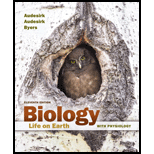
Concept explainers
Many plants car. reproduce sexually or asexually. Strawberries, for example, can reproduce asexually by sending out horizontal stems cabled runners that root and form new plants, or they can reproduce sexually by flowering and producing fruit and seeds. Describe some advantages and disadvantages of each type of reproduction in wild plants. Include in your discussion the important aspects of the environments in which runners and seeds are likely to find themselves.
To describe:
The advantages and disadvantages of sexual and asexual reproduction in wild plants. Also, describe the important aspects of the environment in which runners and seeds are likely to find themselves.
Concept introduction:
Reproduction is a process through which new individuals are produced. Reproduction can be sexual and asexual. Asexual reproduction is a type of reproduction, which does not involve the fusion of sex cells or gametes, and the offspring produced from a single parent and inherit the genetics of that parent only. Whereas, the sexual reproduction involves the fusion of the two gametes that are derived from male and female individuals.
Explanation of Solution
The advantages and disadvantages of sexual and asexual reproduction in wild plants are:
Sexual reproduction:
| Advantages | Disadvantages |
| Sexual reproduction helps in the genetic diversity. | Required high energy cost mating and protecting against rivals. |
| Sexual reproduction involves two parent organisms of the same species that results in genetic variation in offspring. | Produces only a few offspring. |
| The offspring produced by the sexual reproduction can survive in a range of different conditions. | It takes very long of a time to produce the offspring. |
Asexual reproduction:
| Advantages | Disadvantages |
| Only single parent is required to produce the new one. | As no recombination of genes occurs the chance of evolution is very low. |
| It takes very short time for the production of the new offspring. And produce a large number of offspring. | The offspring of asexual reproduction are same as the parent; means the genetic variation is absent. |
| As no crossover and recombination of genes are involved, chances of mutation are very less. | The offspring is vulnerable to the same disease as the parents. As because the genetic material directly passes from the parents to the offspring. |
Runners are the adventitious roots which grow on the earth’s surface just beneath the ground. The nodes are present throughout the roots from where a new plant arises. Strawberry is a common example of plants that grow runners.
Runners and seeds require optimum environmental conditions for the proper growth and development, such as proper temperature (they mostly grow better in medium-high intermediate temperature). They also require the proper amount of water, pH of the soil, and oxygen for the optimal growth and development.
Thus, strawberry is a type of plant that can be developed by both sexual and asexual modes of reproduction. Runners are the modified stem or also called stolons that contain the nodes from where a new plant development.
Want to see more full solutions like this?
Chapter 10 Solutions
Biology: Life on Earth with Physiology (11th Edition)
- Can you described the image? Can you explain the question as well their answer and how to get to an answer to an problem like this?arrow_forwardglg 112 mid unit assignment Identifying melting processesarrow_forwardGive only the mode of inheritance consistent with all three pedigrees and only two reasons that support this, nothing more, (it shouldn't take too long)arrow_forward
- Oarrow_forwardDescribe the principle of homeostasis.arrow_forwardExplain how the hormones of the glands listed below travel around the body to target organs and tissues : Pituitary gland Hypothalamus Thyroid Parathyroid Adrenal Pineal Pancreas(islets of langerhans) Gonads (testes and ovaries) Placentaarrow_forward
- What are the functions of the hormones produced in the glands listed below: Pituitary gland Hypothalamus Thyroid Parathyroid Adrenal Pineal Pancreas(islets of langerhans) Gonads (testes and ovaries) Placentaarrow_forwardDescribe the hormones produced in the glands listed below: Pituitary gland Hypothalamus Thyroid Parathyroid Adrenal Pineal Pancreas(islets of langerhans) Gonads (testes and ovaries) Placentaarrow_forwardPlease help me calculate drug dosage from the following information: Patient weight: 35 pounds, so 15.9 kilograms (got this by dividing 35 pounds by 2.2 kilograms) Drug dose: 0.05mg/kg Drug concentration: 2mg/mLarrow_forward
- A 25-year-old woman presents to the emergency department with a 2-day history of fever, chills, severe headache, and confusion. She recently returned from a trip to sub-Saharan Africa, where she did not take malaria prophylaxis. On examination, she is febrile (39.8°C/103.6°F) and hypotensive. Laboratory studies reveal hemoglobin of 8.0 g/dL, platelet count of 50,000/μL, and evidence of hemoglobinuria. A peripheral blood smear shows ring forms and banana-shaped gametocytes. Which of the following Plasmodium species is most likely responsible for her severe symptoms? A. Plasmodium vivax B. Plasmodium ovale C. Plasmodium malariae D. Plasmodium falciparumarrow_forwardStandard Concentration (caffeine) mg/L Absorbance Reading 10 0.322 20 0.697 40 1.535 60 2.520 80 3.100arrow_forwardPlease draw in the missing answer, thank youarrow_forward

 Biology (MindTap Course List)BiologyISBN:9781337392938Author:Eldra Solomon, Charles Martin, Diana W. Martin, Linda R. BergPublisher:Cengage Learning
Biology (MindTap Course List)BiologyISBN:9781337392938Author:Eldra Solomon, Charles Martin, Diana W. Martin, Linda R. BergPublisher:Cengage Learning Biology 2eBiologyISBN:9781947172517Author:Matthew Douglas, Jung Choi, Mary Ann ClarkPublisher:OpenStax
Biology 2eBiologyISBN:9781947172517Author:Matthew Douglas, Jung Choi, Mary Ann ClarkPublisher:OpenStax Biology: The Dynamic Science (MindTap Course List)BiologyISBN:9781305389892Author:Peter J. Russell, Paul E. Hertz, Beverly McMillanPublisher:Cengage Learning
Biology: The Dynamic Science (MindTap Course List)BiologyISBN:9781305389892Author:Peter J. Russell, Paul E. Hertz, Beverly McMillanPublisher:Cengage Learning Biology Today and Tomorrow without Physiology (Mi...BiologyISBN:9781305117396Author:Cecie Starr, Christine Evers, Lisa StarrPublisher:Cengage Learning
Biology Today and Tomorrow without Physiology (Mi...BiologyISBN:9781305117396Author:Cecie Starr, Christine Evers, Lisa StarrPublisher:Cengage Learning Biology: The Unity and Diversity of Life (MindTap...BiologyISBN:9781305073951Author:Cecie Starr, Ralph Taggart, Christine Evers, Lisa StarrPublisher:Cengage Learning
Biology: The Unity and Diversity of Life (MindTap...BiologyISBN:9781305073951Author:Cecie Starr, Ralph Taggart, Christine Evers, Lisa StarrPublisher:Cengage Learning





